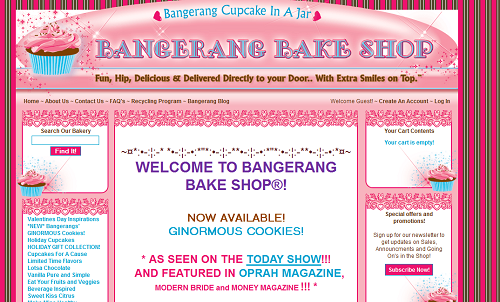Hey, by now you know that your blog needs great content to survive in the blogosphere’s dog-eat-dog world. And if you didn’t know that, well, then Panda-Farmer just came to smack you upside the head a little. Google says you’re welcome. But great content isn’t the lone factor in whether or not your blog is able to attract readers, buzz and authority. Not by a long shot. If you want to court readers and attract new eyes to your blog, there are a few other promises you need to deliver on. Because without those, no one’s even going to notice the message you’re trying so hard to get out.
What 6 non-content things does your business blog need to woo a potential customer? Why don’t you grab yourself a pen.
A Functional Design
Guess what – that first moment someone lands on your blog? Yeah, they don’t even see your content. I mean, they can see the words, but that’s not where their eye is going first. They’re looking at your design, your logo placement, your color choices, your font picks, your navigation, what you thought was so important it had to be above the fold, etc. In other words, they don’t see your sparkling personality or your clever wit. They see what you’re wearing and whether or not you forgot to put on a shirt that morning. And they’re judging you for it the same way they did in high school.
The kiss of death for any great blog with rocking content is to have a design that is distracting or simply doesn’t give it justice. For example – the site for Bangarang Cupcakes?

Maybe the ugliest and least functional site in the history of ugly Web sites. It doesn’t matter how amazing their cupcakes are (and they are amazing), I’m still not going to send it off to my friends. Because I don’t want them judging me for using a site a third-grader would be embarrassed to create.
You don’t want a design that’s going to make people hide their screen like they’re viewing porn, you want a design users will be proud to share , to like, to stumble, to digg. One that matches the brand image you’re trying to create. If your site isn’t functional or it’s not giving off the appropriate brand message, then your good content is wasted. No one voluntarily sits at the loser table.
A Home
If you’re hosting your blog on yourdomain.wordpress.com instead of yourdomain.com, you’re throwing red flags all over your content that a reader may not be able to get over. When I click on your site’s blog link and I’m redirected to a completely different site, I get startled. It means I have to get my bearings again and figure out where I am. And because I have trust issues, it also gets my mind wondering things like:
- Why isn’t your content hosted on your domain?
- Do you not want people to associate the content with your brand? Why?
- Are you trying to hide it?
- Are you going to burn the blog should things go south?
- Have you not totally committed to your blog? Are you going to disappear?
- Is this blog really written by the same people whose company I showed an interest in?
As a user, I now have all these new things I need to worry about. Don’t make me worry or put that doubt in my head. Get your blog off domainname.wordpress.com and host it yourself. It doesn’t matter how pretty your house is if you build it in a sketchy neighborhood.
A Face
Imagine if you showed up to speak at the next search conference looking like this:

You probably wouldn’t be too surprised to hear that people didn’t trust you. They don’t trust you because they can’t see you. There’s no way to relate. The same thing happens when you refuse to put a face on your blog.
In order for someone to trust what you’re saying and think of you as an authority, you have to let them know who you are. Having a byline is a nice start, but even that isn’t enough. I want to know more than just that “Ann” writes the content.
- I want to read Ann’s full About Me page so I can see how long she’s been doing this.
- I want to know what her role at the company is. I don’t care if she’s the window cleaner or the CEO, I just need the image.
- I want to know her credentials and how she got started.
- I want to know what she looks like and maybe some of her interests.
All of these things allow me to visualize Ann and to form a stronger connection to her. That’s how my brain is going to being to recognize her when I see Ann off the blog and hanging out on places like Twitter or Facebook or in the press room at the next conference. The more details I have about her, the more connected I feel both to her and the company she represents. If you don’t give me these details, then my trust issues come out again and I wonder what you’re hiding.
A Viewpoint
What sets you apart from every other blog in your industry is your unique viewpoint. It’s that little something extra that you bring to the conversation that no one else can replicate – maybe it’s your experience, your ability to present the news in different ways, your snark, whatever. Your viewpoint on the world is what will serve as your connecting fiber and what will allow you to attract an audience. Without it, you’re just like every other blog in the world. In other words, you’re boring.
Many corporate blogs or SMBs hold back on sharing opinions or anything that may be different about them in fear that they’ll turn people off. They need to switch their thinking. It’s not like that you’re turning away people, it’s that you’re better targeting the right ones. Why waste time selling to people who never buy anyway? Unify the people who will.
Media
Words are great, but most people like a little variety in their diet. They want to be surprised, to be entertained and to have new things waiting for them when they hit your blog. That means it’s in your best interest to experiment with all different types of media on your blog – images, audio, video, slideshows, UGC content, etc. Find your comfort zone and the content your users most like to soak up, but then give them something they’re not expecting to keep them on their toes. I like chicken, but that doesn’t mean I want to eat it every day.
Shareability
All that awesomesauce content isn’t going to do anything for you if you haven’t put the mechanics in place to allow people to easily share it. If you haven’t read out post on how to optimize your content sharing process, maybe bookmark it for later. It’s simply not enough to litter your site with social media sharing options and to expect that users will know what to do with them. Just like you can’t expect people to leave reviews. To get people to pass your stuff on, you really need to make sure you’re using the right buttons, that you’re optimizing how they work, and that you’re encouraging readers to actually use them. It really is about finding out HOW people are naturally sharing your content and then making it easier for them to do that. If you’re not doing your part to optimize the task, you may as well save all those fresh blog ideas as Drafts. Why even publish them?
The importance of “creating great content” is something that’s constantly drilled into us from all angles. But it’s not the lone factor in business blog success. The non-content stuff is just as important.
